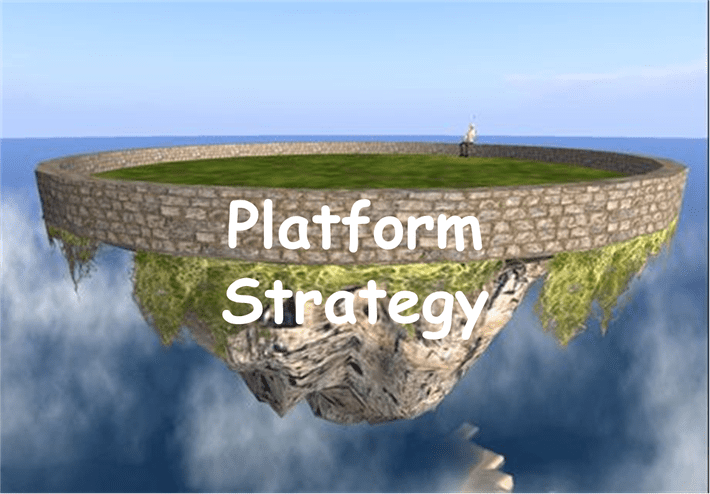Summary: A new business model strategy based around intermediary platforms powered by AI/ML is promising the most direct path to fastest growth, profitability, and competitive success. Adopting this new approach requires a deep change in mindset and is quite different from just adopting AI/ML to optimize your current operations.
 As a data scientist you may be wondering why you need to be concerned about strategy and business models. It’s simple. Different types of AI/ML are most appropriate for different business objectives. So whether you’re a data scientist being asked to plan and present the most appropriate portfolio of projects, or a CXO looking to support your new digital business model, you need to understand the relationship between data science and strategy.
As a data scientist you may be wondering why you need to be concerned about strategy and business models. It’s simple. Different types of AI/ML are most appropriate for different business objectives. So whether you’re a data scientist being asked to plan and present the most appropriate portfolio of projects, or a CXO looking to support your new digital business model, you need to understand the relationship between data science and strategy.
In our last article we laid out the four major AI/ML powered business models. We set up a structure to help you think about “AI Inside”, essentially pasted on and used to optimize an existing old-style business model versus “AI-First”, business models that can lead to real digital transformation.
AI-First models are typically associated with startups so not necessarily the first place a mature existing business would look for a strategy in its digital journey. But hidden in plain sight within AI-First is a business model strategy so bold that mature companies that have embraced it have outpaced their competitors by a wide margin. That’s adopting a “Platform Strategy”.
Platform Strategy (Platformication)
Platformication isn’t new. In fact academics and business leaders observed this new model in the rise of the likes of Facebook, Google, Amazon, Uber, Airbnb, and others. There have been major conferences focusing on Platform Strategy dating back to at least 2013.
And if the spectacular success of these internet leaders weren’t enough, try these:
 13 of the top 30 global brands are now platform companies and growing strong.
13 of the top 30 global brands are now platform companies and growing strong.- Platform companies trade at 4 to 11 X revenues, compared to tech companies at 3-7X, and services companies at 1-3X. And note that’s a multiple of revenues not profit! (Barry Libert, Professor Digital Transformation, DeGroote School of Business, McMasters Univ., Toronto)
- Leading platform companies like Uber, Airbnb, and Instagram eclipsed the market cap of their traditional competitors in just 6 or 7 years compared to the decades those traditional companies took to achieve that.
What Exactly is Platform Strategy?
According to Geoffrey Parker and Marshall Van Alstyne, the two academic researchers at the MIT Initiative on the Digital Economy most frequently cited for their work in this field, Platform Strategy is technically described as a two-sided market, or two-sided network.
The centerpiece is an intermediary economic platform with two distinct user groups, typically buyers and sellers, which adds value to the transactions by exploiting Metcalfe’s law, showing that the value of the network increases with the number of users.
These aren’t as rare as you might think and include:
- Credit cards (cardholders and merchants)
- Operating Systems (end users and developers)
- Recruitment sites (job seekers and hiring companies)
- Dating sites (date seekers on both sides)
- Ride Sharing (drivers and ride seekers)
- Travel sites (travelers and hotels, airlines, and car rental providers).
There are several key characteristics here:
- Economies of scale allow the platforms to provide increasing levels of benefit to both parties. These might be economic in terms of sales volume or discounts. But they are equally likely to be intangible.
- Information and interactions are the source of value. The platform can customize the user experience to both users’ benefit further increasing usage. This is where AI/ML becomes critical.
- The resources being organized aren’t owned by the platform company and even the management of the network is mostly provided by the participants (e.g. providing profiles, learned preferences, pricing and product/services tailored by providers).
This is the antithesis of the old product/service or channel focused business models. Growth can occur at near zero marginal cost except for the incremental cost of storing and analyzing data.
Can Platform Strategy Exist Without AI/ML?
The short answer is no, AI/ML is central to customization and value added that make the platform users return. This new flywheel of commerce requires efficiency, and in the platform model this requires the efficient matching of buyers and sellers. This means both knowing a great deal about both groups’ characteristics and motivations (from knowledge harvested from their transactions) and the ability to execute as they arrive at the platform.
This might take the form of ML scoring, recommender techniques, or dynamic pricing, and might use NLP for input or output, as well as image processing to facilitate visual search.
This is a wholly new business model that couldn’t exist prior to the emergence of AI/ML over the last two decades.
When asked how platforms differentiate themselves from the pack (yes there is now competition among platform companies), Glenn Fogel the CEO of Bookings Holdings (Kayak, Priceline) says:
“You’ve got to provide more value, both to the customer who’s going to be traveling and the other side—the host, or the supplier, or the hotel owner. The way you do that is using technology. It’s getting really smart people— Al specialists, people who understand the data—so you can come up with a better solution for both sides of the marketplace.”
Can any Traditional Business Become or Create a Parallel Platform?
 Here’s the real question that you as a data scientist in a mature company can help answer. Is this really a strategy available to many companies or are these opportunities rare?
Here’s the real question that you as a data scientist in a mature company can help answer. Is this really a strategy available to many companies or are these opportunities rare?
First of all there is no agreed or established methodology for applying this strategy to a company. There are many articles on the topic and many strategy consultants with an opinion. Here are just a few:
- There are buyers and sellers (suppliers) who aren’t you. That is, you have or can create an intermediary position in the transaction. Look for markets in which there are readily identifiable middle men or where a middle man should exist. Most distributors fall in this category.
- Can you use information or community to add value to what it sells. That value can either be directly economic or intangible UX elements like convenience or customization of the experience.
- Platform business are most likely to succeed in highly fragmented industries with non-scalable gatekeepers in which information is both a significant source of value and extremely asymmetrical.
- The emergence of platform disruption is less likely in resource-intensive industries that are subject to high levels of regulatory control and high failure costs.
- Since value depends on scale, it is more likely that the applications will be B2C, but that doesn’t rule out B2B and we’ve already seen examples of C2C user-to-user such as dating sites.
- Every business has value represented by their customers, data, products, brands, technologies, and processes. The challenge is how can that be packaged and made available to others for leverage. More importantly, you need to not only give away that information and value freely but also to have your network of users contribute their own as well.
This still leaves many unexplored questions such as are services a more logical choice than hard goods for Platformication? Like many new trends, we can learn something by looking at examples, particularly unexpected successes.
Some Less Expected Successful Platformications
AXON (fka Taser) pivoted from device manufacturer (Tasers and lapel cameras) to an information platform that is its center of growth. AXON offers both free and paid storage for the vast amount of image data generated by their cameras and those of competitors and in turn is able to use AI image processing to provide a variety of new services including training their AI image recognition capabilities.
Users need to store their images somewhere that are growing rapidly in volume. The more images AXON has to train and improve its AI, the more their clients will utilize their service. AXON pays nothing other than the incremental storage cost to gain huge amounts of training data.
Nike and Under Armour: Both these companies have created valuable platforms that are fitness ecosystems for their customers. Both companies acquired different fitness tracker device manufacturers and both have expanded customer use beyond footwear and apparel by becoming the information hubs their customers use to record their progress. Nike goes further by adding sensors to their shoes that can interact with the fitness trackers and be recorded on their site. Under Armour adds fitness plans, videos, and products on its platform.
McCormick Foods: This 126-year-old company that sells herbs, spices, and condiments had fully exploited traditional growth strategies of line and channel extension, as well as vertical integration along its supply chain. Their pivot was the concept of using recipes and taste profiles to build a food-based platform.
The hidden value unlocked was the ability of McCormick’s taste laboratories to distill dozens of flavor categories (such as minty, citrus, floral, garlicky, or meaty) that can be used to describe almost any recipe. Based on personal preferences, the system can predict what new recipes an individual is likely to prefer.
And the McCormick platform community can modify recipes and upload the new versions, creating ever-expanding flavor options and helping to identify new food trends, generating information that’s useful not only to the platform’s users but also to managers of grocery stores, food manufacturers, and restaurateurs.
Ghost Kitchens: This story is about how food delivery platforms (Door Dash, Grubhub, and similar) unlocked the potential for unused supply resources. The rise of these on-demand food delivery services has created 24/7 demand for food preparation that the traditional restaurant industry wasn’t prepared to provide. This has given rise to thousands of entrepreneurs contracting to use existing commercial cooking facilities creating virtual restaurants that only serve online customers. The German startup Keatz recently secured $14M in funding to begin consolidating this new supply source that didn’t exist before the food delivery platforms enabled it.
Perhaps the biggest lesson for pursuing Platformication is this. To benefit from network effects the focus of attention must shift from inside the company to outside. This also means that traditional measures of success will need to shift to platform measure like engagement and number of unique monthly visitors and users.
These are big shifts in thinking and require expertise in AI/ML to implement. Those who successfully adopt can look forward to growing much more rapidly than traditional competitors.
Other articles on AI Strategy
Now that We’ve Got AI What do We do with It?
Capturing the Value of ML/AI – the Challenge of Offensive versus Defensive Data Strategies
The Case for Just Getting Your Feet Wet with AI
The Fourth Way to Practice Data Science – Purpose Built Analytic Modules
From Strategy to Implementation – Planning an AI-First Company
Comparing the Four Major AI Strategies
Comparing AI Strategies – Systems of Intelligence
Comparing AI Strategies – Vertical versus Horizontal.
What Makes a Successful AI Company – Data Dominance
AI Strategies – Incremental and Fundamental Improvements
Other articles by Bill Vorhies
About the author: Bill is Contributing Editor for Data Science Central. Bill is also President & Chief Data Scientist at Data-Magnum and has practiced as a data scientist since 2001. He can be reached at:

 13 of the top 30 global brands are now platform companies and growing strong.
13 of the top 30 global brands are now platform companies and growing strong.